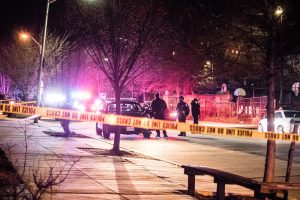There’s a steady drumbeat building around here to preserve the boyhood home of jazz great Cab Calloway. The old rowhouse sits in the 2200 block of Druid Hill Avenue, not exactly an urban paradise, and it’s scheduled to be demolished by the city’s housing department.
Calloway was the great band leader who went up to Harlem andgave the world “Minnie the Moocher,” the first number by an African-Americansinger to break through the color line and sell a million records.
But Cab’s only part of a Baltimore heritage that’s slipping from memory and should be preserved, not merely by holding onto the ruins of an ancient house but by something better.

He’s also part of another heritage. Calloway’s a graduate of the city’s Frederick Douglass High School. A year behind him at Douglass was Thurgood Marshall, whose legal skills helped rewrite the nation’s laws on racial segregation.
In Marshall’s senior year at Douglass, another pretty good kid named Clarence Mitchell Jr. entered the school. Years later, while Marshall was working the nation’s courts, Mitchell at the NAACP was convincing Congress to change so many racially-discriminatory laws that he became known as “the 101st Senator.”
Mitchell had some pretty good classmates, too. There wasJuanita Jackson, whom he later married. She became a powerful civil rightsleader and the first black female attorney in Maryland. And there were classmatesAnne Wiggins Brown and Avon Long. Anne was the original Bess, and Avon was theoriginal Sportin’ Life, in the immortal Gershwin opera, “Porgy and Bess.”
Imagine all these people from one little high school, in onelittle era, in one city, who had such a profound effect on American culture.
And they’re just a small sample of some great names thathave come out of here, and their stories are cheated – and so is the city’ssense of itself – if we don’t do something more than hold onto homes where theypassed through long ago.
We’ve got a statue of Thurgood Marshall outside the federalcourthouse, but what about statues honoring some of these other giants whohappened to come out of Douglass High? And, while we’re at it, how aboutstatues for some other local giants?
Writers such as Leon (“Exodus”) Uris and two-time Pulitzer Prizewinner Russell Baker and novelist Anne Tyler. Musicians such as drummer andband leader Chick Webb and rock ‘n’ roll types such as Frank Zappa and lyricistJerry (“Hound Dog”) Leiber.
And movie directors like Barry Levinson and John Waters, and politicians like House Speaker Nancy Pelosi and Sen. Barbara Mikulski. How about Dr. Ben Carson (in his surgical gear) and Jacob Beser, the only man who flew on both the atomic bomb missions that ended World War II?
Why are statues important? Because they give all who live and work in a city a sense of their hometown’s identity, and its historic greatness – and its potential. Boy, do we need that inspiration now.
We’ve got plenty of ballplayers honored that way, but they’re not the hometown’s only immortals. We need to restore Baltimore’s sense of itself as a great city.
We used to be known as “the Monumental City.” It’s time for an update on our monuments.

A former Baltimore Sun columnist and WJZ-TV commentator, Michael Olesker is the author of six books. His most recent, “Front Stoops in the Fifties: Baltimore Legends Come of Age,” was reissued in paperback by the Johns Hopkins University Press.





